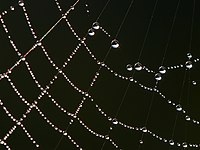
Photo from wikipedia
We present a study of the mechanical behavior of planar fibrous mats stabilized by inter-fiber adhesion. Fibers of various degrees of tortuosity and of infinite and finite length are considered… Click to show full abstract
We present a study of the mechanical behavior of planar fibrous mats stabilized by inter-fiber adhesion. Fibers of various degrees of tortuosity and of infinite and finite length are considered in separate models. Fibers are randomly distributed, are not cross-linked, and interact through adhesion and friction. The variation of structural parameters such as the mat thickness and the mean segment length between contacts along given fibers with the strength of adhesion is determined. These systems are largely dissipative in that most of the work performed during deformation is dissipated frictionally and only a small fraction is stored as strain energy. The response of the mats to tensile loading has three regimes: a short elastic regime in which no sliding at contacts is observed, a well-defined sliding regime characterized by strain hardening, and a rapid stiffening regime at larger strains. The third regime is due to the formation of stress paths after the fiber tortuosity is pulled out and is absent in mats of finite length fibers. Networks of finite length fibers lose stability during the second regime of deformation. The scaling of the yield stress, which characterizes the transition between the first and the second regimes, and of the second regime's strain hardening modulus, with system parameters such as the strength of adhesion and friction and the degree of fiber tortuosity are determined. The strength of mats of finite length fibers is also determined as a function of network parameters. These results are expected to become useful in the design of electrospun mats and other planar fibrous non-cross-linked networks.
Journal Title: Soft matter
Year Published: 2019
Link to full text (if available)
Share on Social Media: Sign Up to like & get
recommendations!